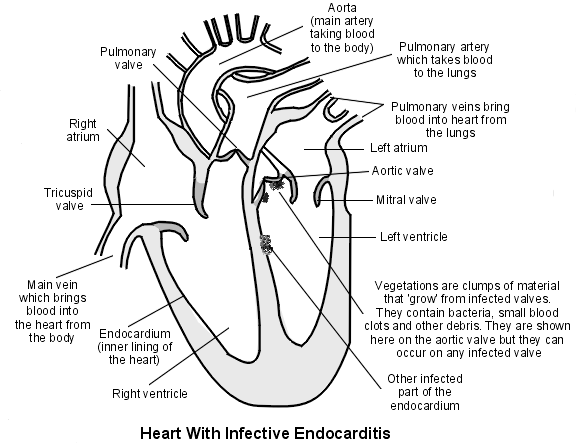Endocarditis
Encocarditis is the inflammation of the inner tissue of the heart AKA the Endocardium. It usually involves the heart valves (natural or prosthetic valves).
Infective Endocarditis
Infective Endocarditis is a form of endocarditis in which the causative agent is an infectious agent (most commonly bacteria) but other agents as well could be the cause.
Mechanism of Infection
To begin with, micro organisms usually live in our mouth, skin, intestine and urinary track, but not in our blood. However some microorganisms can enter the bloodstream (via surgery or dental procedure).
For most people theses microorganisms don’t pose a threat to the body and are dealt with by the immune system, but if one the heart valves becomes or are damaged (e.g Rheumatic Fever or prosthetic valve surgery). The body will typically heal those valves by sending immune cells platelets and fibrin. However if by some chance the microorganism gets trapped under these cells, it will lead to development of clumps of tissue on the heart’s valves, which are called Vegetations.
These vegetations are dangerous because they aren’t firmly attached and can break off entering into the blood stream (Embolism). If a large enough embolus breaks off it can lead to blockage of the smaller arteries depriving that specific area of blood. The damage of the blockage of blood depends on which area is has the blood supplied been altered, for example if it occurred in the brain will cause stroke, loss of sensation, partial blindness, even death.
Dental Management
Preventive antibiotics prior to a dental procedure are advised for patients with:
- Artificial heart valves
- A history of infective endocarditis
- Certain specific, serious congenital heart conditions, including
- unrepaired or incompletely repaired cyanotic congenital heart disease, including those with palliative shunts and conduits
- A completely repaired congenital heart defect with prosthetic material or device, whether placed by surgery or by catheter intervention, during the first six months after the procedure
- Any repaired congenital heart defect with residual defect at the site or adjacent to the site of a prosthetic patch or a prosthetic device
- A cardiac transplant that develops a problem in a heart valve.
Antibiotic Regimen
The Antibiotic Regimen for management of patients with Infective Endocarditis is as following:
| Situation | Agent |
Dosage 30 -60 minutes before Procedure |
|
| Adults | Children | ||
| Orally | Amoxicillin | 2 grams | 50 Milligram per kilo |
| Unable to take Orally | Ampicillin | 2 Gram IM or IV | 50 mg/Kg IM or IV |
| Cefazolin | 1 Gram IM or IV | 50 mg/Kg IM or IV | |
| Ceftriaxone | 1 Gram IM or IV | 50 mg/Kg IM or IV | |
| Orally but allergic to penicillin |
Cephalexin | 2 Grams | 50 mg/Kg |
| Clindamycin | 600 Milligram | 20 mg/Kg | |
| Azithromycin | 500 Milligram | 15 mg/Kg | |
| Calarithromycin | 500 Milligram | 15 mg/Kg | |
| Unable to take Orally + allergic to penicillin |
Cefazolin | 1 Gram IM or IV | 50 mg/Kg |
| Ceftraiaxone | 1 Gram IM or IV | 50 mg/Kg | |
| Clindaymycin | 600 mg IM or IV | 20 mg/Kg | |
- IV = Intra Venous / IM = Intra Muscular / g= Gram / mg = Milligram/ mg/kg = milligram per kilo
- Cephalosporins shouldnt be used with a person who has a history of anaphylaxis, angioedema or urticaria with penicillins or ampicillin.
- Table Courtesy American Heart Association and American Dental Association.
- Guide lines are from The Journal of the American Dental Association January 2008 vol. 139 no. suppl 1 3S-24S
Images Courtesy of Wikipedia: http://en.wikipedia.org/wiki/Infective_endocarditis
OziDent Members Only
The rest of article is viewable only to site members,Please Register and/ or Confirm registration via EmailHere.If you are an existing user, please login.
